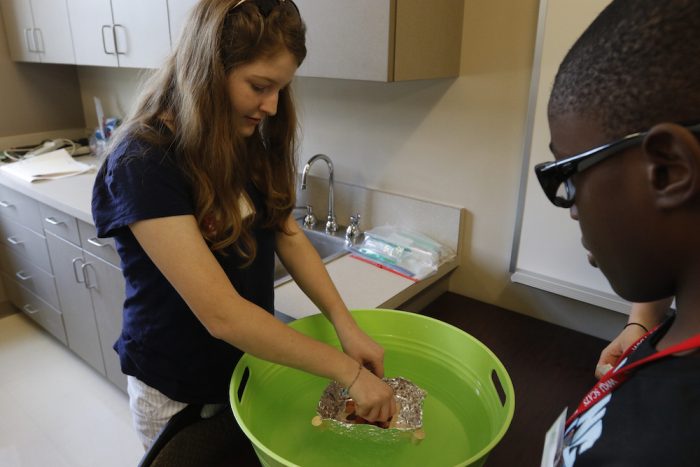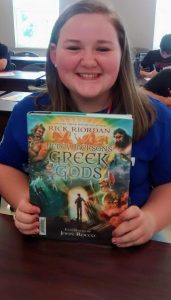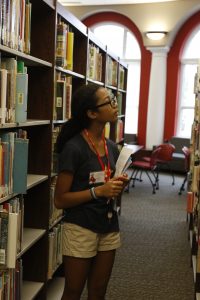by Erika Solberg

E. Paul Torrance, pioneer in the study of creativity, wrote, “Creativity is almost infinite. It involves every sense – sight, smell, hearing, feeling, taste and even perhaps the extrasensory. Much of it is unseen, nonverbal and unconscious. Therefore, even if we had a precise concept of creativity, I am certain we would have difficulty putting it into words.”* For gifted and talented young people whose academic worlds sometimes revolve around high test scores, right answers, and the mastery of specific skills, developing creativity may feel like a waste of time – how can they know if they are “being creative” and why should they bother, if creativity has no clear definition?
At the same time, gifted and talented children often excel at creativity, and because creativity is, as Torrance wrote, infinite, it is an area where there can never be any limits on learning, where gifted thinkers can roam as far and as long as they would like. Creativity is also crucial to many fields, not just fine arts and communication but also science and engineering. This year at SCATS, creativity is on display in a broad range of classes as teachers work with students to see what is not yet there, find connections no one has noticed, and build what does not yet exist.
Engineering
In Solving the World’s Problems One Challenge at a Time, teacher Sarah Mills focuses on the engineering design process of creating, testing, and improving. She presents her class with unique, real-world problems designed to stretch their creative thinking skills. On the first day of class, students could be heard testing out ideas as they strategized how to build a three-inch structure strong enough to hold a book using only gumdrops and toothpicks:
“What if we broke the toothpicks up?”
“We can’t just make a triangular prism because nothing would actually stick.”
“Can we use triangular prisms to make a rectangular prism?”
“Hmmmm.”
Creativity is crucial in the engineering process because there is no one right answer to a problem and because engineers always have to work within real-word constraints like time and materials. Later in the week, the students worked in small teams to design a boat that could hold as many pennies as possible without sinking. Each team was given an imaginary budget of $400 with which to buy supplies such as large lumber (large craft sticks, $25 each) small lumber (small craft sticks, $10 each) buoys (corks, $50 each), and welding materials (Elmer’s glue, $20 per bottle, or wood glue, $25 per ounce). Teams could win prizes not just for building a boat that bore the most weight but also for being the most cost-efficient.

Maleah Preston of Jamestown and Grayson Duvall of Bowling Green were having problems: they had built their boat from small craft sticks, but because they chose Elmer’s glue rather than the more expensive wood glue, their sticks weren’t staying together, and the glue was taking too long to dry. Despite some frustration, however, they were having fun because, Maleah said, “We’re getting to solve our own problems.” They also knew they would have an opportunity to redesign their boat in the second round of the challenge, giving them a chance to imagine a whole new solution.
Izzy Sanchez of Leitchfield and Logan Abel of Owensboro had more success: their boat took on 456 pennies before submerging in the large tub of water their teacher has provided. Izzy explained that they had built their boat with a double layer of tinfoil molded into a circle with inch-tall sides so “we could trap air between the layers.” They had placed straws on the bottom in their original design, but the straws wouldn’t stick, and they soon realized they didn’t need them.
Sarah sees creativity in the solutions her students devise and also in the questions they ask, some of which she has not anticipated: “They get so technical with their questions — it’s great.”
Performance
Professional clown Nick Wilkins has taught Clowning at SCATS for decades, and every time is an opportunity to teach young people how to communicate creatively. On Wednesday this week, he demonstrated the make-up process on Seth Pendleton of Louisville. The class gathered around while he applied red to Seth’s cheeks and white swirls around his mouth and eyes.
The students, who will have a chance to put on their own clown faces next week, asked questions such as “Do you put stuff on his eyelashes?” and “Do you have to do the whole face?”
The process took more than thirty minutes, but Seth was patient, breaking only once to stand and do a quick Fortnite dance before Nick continued, outlining his eyes with black and drawing red highlights down his face. He finished with the mouth, adding buck teeth. After applying powder, Nick asked Seth if he wanted him to spray the whole face with fixative.
“Will it make me pop?” Seth asked.
“Yes,” Nick replied.
“Hit me.”
The class laughed and applauded as Seth and his finished face stood up, but then it was time to test it out. Seth stood at the opposite end of the room from his classmates and made happy, excited, and sad faces to show the effects the makeup had on communicating emotions.
After all, clown makeup is a creative activity not only because students design their own faces; it is also about how to use that face to connect with others. Nick says, “I believe the creativity of children in general is decreasing because they can find all they need on social media.” When students wear clown make-up, or when he gives them a white mask that covers their features and instructs them to “make us laugh,” he is pushing them to think and connect in new ways. “It’s hard for some, but with encouragement they’ll get there. This is about communication — it’s vital.”
Math
Opportunities for creativity abound in Bradley Boaz’s math-heavy Theme Park Development. The students use concepts such as perimeter, area, and ratios to design their dream park, creating a blueprint that meets the requirements and limitations set by Bradley. They also need to come up with the logo, mascot, brochure, and overall theme for the park. All these tasks require imagination and problem-solving — in other words, creative thinking.
One team, made up of Grant Ellis of Russellville, Taylor Brundidge of Louisville, and Sophia Frassinelli of Bowling Green, has created a water-themed park called Ocean Nights. On Wednesday, Grant drew the cover of the brochure with its mermaid mascot, while Sophia and Taylor worked on the blueprint. Taylor revealed her favorite ride was their 5D Theater which employed wind and water as its two extra dimensions.
Meanwhile, Anuj Ravishankar of Bowling Green, Molly Norris of Memphis, TN, and Henry Martin of Louisville were creating Candyland. Henry worked on the brochure while Maddy drew the mascot, a candy panda bear named Gummbo. Anuj, who was finalizing the blueprint, said the most interesting feature of their park was the Candy Castle with a restaurant in the middle that served nothing but candy. Henry joked, “We’re interested in making our customers fat and happy — and dry of every penny they have!”
Humanities

Greek mythology, taught by Tamara O’Nan, ties together learning about ancient Greece with creative ways of presenting knowledge to others. Midway through the first week, the students were hard at work in a classroom with a photo of a statue of Socrates on the screen and Greek flute music playing in the background. They were doing a tic tac toe learning activity where they had choice about what to learn and how to present the information. Subsequently, even though they all had access to the same collection of books about Greece, every student’s output was different, and all incorporated creativity.
Madeline Gao of Knoxville, TN, and Micah Patrick of Lexington were both studying the Titans, but Madeleine was writing haikus about each one while Micah was composing song lyrics. Bella Soares of Pearland, TX, and Colin Reed of Bowling Green both learned about life in ancient Greece, but Bella was creating a brochure and talk show interview while Colin designed a timeline for a typical day.
Three students studied the Pegasus, but even though all three chose to draw the creature and write facts about it around the picture, each creation was distinct. Layth Hammad of Bowling Green took a lot of time with his facts, including that the Pegasus was made from Medusa’s blood after she was beheaded. Maddy Kirk of Bowling Green focused more on the artwork: her beautiful Pegasus was surrounded by artistic handwriting. Lainey Wilemon of St. Petersburg, FL, produced a diagram that looked like it was from a mythical anatomy book.
Whatever topic the student chose to study, they had to form a vision of the best way to get that new knowledge across, and then execute that vision.
Writing

In Poetry Corner with Christy Abel, students study poems and write their own. The class emphasizes that creativity also requires craftsmanship — the tools with which imagination can work. On their first day, students looked at Mary Oliver’s “When Death Comes” and talked about her use of figurative language, such as saying death is “like the hungry bear in autumn” and “like an iceberg between the shoulder blades.” Then Christy had them move into creating their own figurative language by asking them to come up with different ways to describe a baby.
Later in the week, the class wrote haikus, including one that sums up the camp experience:
SCATS is the best camp
We have jokes like visor kid
And we have white squirrels
***
No matter the field of study, creativity may be indefinable, but it is also essential. Nurturing their creativity is one of the many ways that SCATS campers are learning to think big and think new about what they can do, and about what the world can offer.
More information and resources on creativity and giftedness are available at these sites:
http://www.nagc.org/nurturing-creativity
http://www.hoagiesgifted.org/creatively_gifted.htm
* Torrance, E. Paul. “The Nature of creativity as manifest in its testing.” The Nature of Creativity: Contemporary Psychological Perspectives. Robert J. Sternberg, ed. New York: Cambridge University Press, 1988. 43-75.
